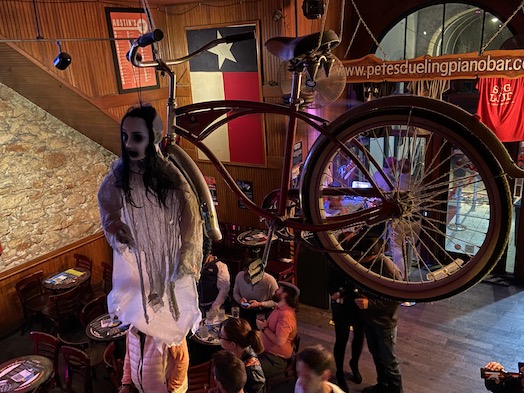Running a P1, P2, P3 Team Prioritization Meeting

Really is anything more scary than prioritization???; Picture taken at Pete's Dueling Piano Bar, Austin, TX; Recommended
I am a member of an 8 person team that is:
- part of a non profit
- distributed all over the country
- trying to get started on a new initiative and find our footing; we are about 1 year old (I've only been here for 2 months)
- just had our first offsite
- juggling way too much work hence the need to prioritize
At the offsite I witnessed a fascinating exercises in setting priorities that my boss, Dave Sifry, orchestrated. I haven't seen prioritization done quite this way in the past so I wanted to write down how this was done. I also made one important contribution during the process
Step 1 - Terms
There are three types of priorities:
- P1 - something that you have to do the instant it comes up; drop everything and worry about it
- P2 - something that you can do on the second day
- P3 - something that can wait 3 days
Step 2 - List What You Do
This was a simple process:
- Put all people in the same room with a shared note space (white board or easel size post it )
- Designate a person to write all the things that you do
- Time bound the exercise to say 20 minutes and try and make sure that each person's tasks are listed
Pro Tip 1: Make sure that the person listing the priorities on the white board / easel size post it has decent hand writing. Our initial writer was close to illegible so we had to rewrite them all.
Pro Tip 2: Use a different color pen for each person's tasks
Step 3 - Apply the Priorities
You then go through the tasks and write down P1, P2, P3 next to each task. Inherently you are going to err on the side of P1 which brings us to My Contribution.
My Contribution
My contribution to this process was actually pretty simple. I asked this question:
How many top level, P1, priorities can a team our size support?
My boss had a brilliant answer - "maybe one per person, possibly less".
I really wasn't trying to be a jerk; just trying to apply my normal engineering perspective to things.
This limited us to 6 or 7 P1 priorities and that forced the work in Step 3 to be restructured and a bunch of items to move from P1 to P2 or P3.
The really interesting outcome of this exercise was that my own work, Engineering, ended up being a P3 priority! And the reason was simple – we are in early, early stages of the product life cycle and while what we are doing is interesting, it isn't yet anything exposed to the public so other things have to be the top priority.
Note: We are a non profit that does advocacy and public policy work so we have an obligation to be responsive to the public / deal with crisis events that come up somewhat regularly.
Step 4 - Document It
The final step is to take an incredibly messy working document and then distribute it across the team. This could be done with Google Docs, Slack or some other mechanism.
Posted In: #management #startup #offsite #team #meetings